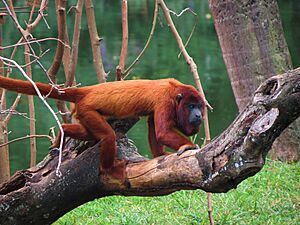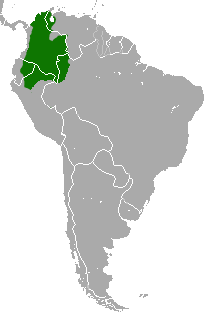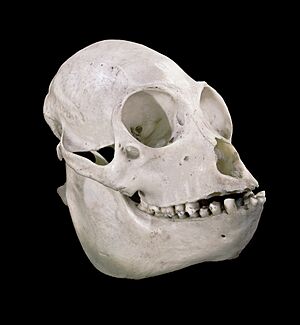Colombian red howler facts for kids
Quick facts for kids Colombian red howler |
|
|---|---|
 |
|
| Conservation status | |
| Scientific classification | |
| Genus: |
Alouatta
|
| Species: |
seniculus
|
 |
|
| Colombia red howler range | |
| Synonyms | |
|
Simia seniculus Linnaeus, 1766 |
|
The Colombian red howler or Venezuelan red howler (Alouatta seniculus) is a type of howler monkey. These monkeys live in South America, specifically in the western Amazon Basin. You can find them in countries like Venezuela, Colombia, Ecuador, Peru, and Brazil.
Scientists sometimes change how they classify animals. For example, the howler monkeys in Bolivia are now seen as a different species called the Bolivian red howler. Also, howlers in northeastern South America and Trinidad are now called the Guyanan red howler. All howler monkeys belong to a group called Atelidae, which is part of the New World monkey family.
Contents
About the Colombian Red Howler
It can be tricky to tell male and female red howlers apart just by looking at them. Males are usually between 49 to 72 cm long, and females are a bit smaller, from 46 to 57 cm. Males weigh about 5.4 to 9 kg, while females weigh 4.2 to 7 kg.
They have a very long tail, about 49 to 75 cm! This tail is special because it can grab branches like an extra hand. It's covered in fur, except for the last part underneath, which helps them grip. Both males and females have a deep reddish-brown fur color. This color can change slightly as they get older. Their faces are surrounded by fur, and they have short, flat noses.
The jawbone of the red howler monkey is quite large. This big jaw and a special bone in their throat (called the hyoid bone) help them make their famous loud calls. They also have a unique ear bone structure, which is different from most other New World monkeys.
These monkeys are active during the day (this is called diurnal). They are also arboreal, meaning they spend most of their lives high up in the trees. They usually move by walking on all fours along branches. Their long, gripping tail helps them balance and hold on. Their hands and feet are also designed for grasping, with a wide space between their second and third fingers, making it easier to move through the trees.
Living Together
Colombian red howlers live in small groups, usually with three to nine monkeys. Most groups have about five to seven members. These groups often have one or two males and several females with their young. One male is usually the leader, called the alpha male. He guides the group to new food spots and protects them. The females in the group are mainly responsible for taking care of the babies.
Venezuelan red howlers are most active in the morning. This is when they move around to find new places to eat. They are famous for their "dawn chorus," which is a loud roaring and howling sound. The males in the group make most of these calls. Their roars can be heard up to 5 km away in the forest!
These loud calls help other howler groups know that an area is already taken. This prevents fights between groups, which saves a lot of energy. Since their diet is low in sugar, saving energy is very important for them. The calls also help spread out the groups, so there's less competition for food.
What They Eat
A. seniculus monkeys are folivores. This means they mostly eat leaves. However, they also eat nuts, small animals, fruits, seeds, and flowers to get important nutrients. These extra foods give them the sugar they need for energy and growth. Leaves are the most important part of their diet; they can't live without them for more than a week. They eat both older and younger leaves, but older leaves often have more nutrients.
These howler monkeys can eat tough, fibrous leaves because of their special teeth. They have narrow front teeth (incisors) to help them bite off leaves. Their back teeth (molars) have sharp, shearing crests that help them chew their food well. They also have complex stomachs to help digest the leaves. Their large intestines contain special bacteria that break down leaves. This part of their gut can make up about a third of their total body size!
Like other New World monkeys, Venezuelan red howlers have a specific set of teeth. In both their upper and lower jaws, they have two incisors, one canine, three premolars, and three molars.
How They Have Babies
Males compete to find mates. A female might attract a male by moving her tongue around to start mating. If a male doesn't respond, she will try with another. The mother carries her baby for about 190 days. The young monkey will stay with its mother for 18 to 24 months.
Once young males grow up, they usually leave their birth group. These males then try to join a new group. When a new male takes over a group, he often tries to replace the previous leader's offspring to ensure his own genes are passed on. Sadly, less than 25% of the young monkeys survive when a new male takes over.
Different Types of Red Howlers
Scientists have traditionally listed three subspecies of this howler. However, research has shown that some of these might be distinct species.
- Colombian red howler, Alouatta seniculus seniculus
- Ursine howler, A. s. arctoidea
- Juruá red howler, A. s. juara
The A. s. juara has recently been described as its own separate species, Alouatta juara.
See also
 In Spanish: Mono aullador rojo para niños
In Spanish: Mono aullador rojo para niños



